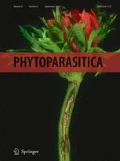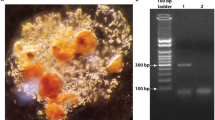Abstract
The pine wood nematode (PWN), Bursaphelenchus xylophilus, is a disastrous pathogen of the pine forests in East Asia and Europe. Plant quarantine is one of the most important ways to prevent its infection in current situation. A nested polymerase chain reaction (PCR) assay targeting the topoisomerse I gene has been developed to detect PWN in this study. To assess the specificity of the assay, 44 morphologically characterized nematode isolates including B. xylophilus, B. mucronatus, B. hofmanni, Seinura wuae, S. lii and Aphelenchoides macronucleatus were tested. Positive reactions characterized by amplification product of 509 bp were shown from all isolates of PWN. The nested PCR assay can detect 50 femtogram (fg) of template DNA or one individual nematode, as small as an egg. The validity was evaluated by analyzing the nematode samples extracted from the nematode-infested wood in the field. These results show that the assay is a specific, sensitive method for detection of PWN with the potential in relation to the pest risk assessment and quarantine regulations.




Similar content being viewed by others
References
Abad, P. (2000). Satellite DNA used as a species-specific probe for identification of Bursaphelenchus xylophilus. EPPO Bulletin, 30, 571–574.
Berry, S. D., Fargette, M., Spaull, V. W., Morand, S., & Cadet, P. (2008). Detection and quantification of root-knot nematode (Meloidogyne javanica), lesion nematode (Pratylenchus zeae) and dagger nematode (Xiphinema elongatum) parasites of sugarcane using real-time PCR. Molecular and Cellular Probes, 22, 168–176.
Bialek, R., Ibricevic, A., Fothergill, A., & Begerow, D. (2000). Small-subunit ribosomal DNA sequence shows Paracoccidioides brasiliensis closely related to Blastomyces dermatitidis. Journal of Clinical Microbiology, 38, 3190–3193.
Cao, A. X., Liu, X. Z., Zhu, S. F., & Lu, B. S. (2005). Detection of the pine wood nematode, Bursaphelenchus xylophilus, using a real-time polymerase chain reaction assay. Phytopathology, 95, 566–571.
Chen, F. M., Ye, J. R., & Wu, X. Q. (2007). Detection technique of Bursaphelenchus xylophilus using real time PCR. Journal of Nanjing Forestry University, 31(4), 121–124.
De Guiran, G., Lee, M. J., Dalmasso, A., & Bongiovanni, M. (1985). Preliminary attempt to differentiate pinewood nematodes (Bursaphelenchus spp.) by enzyme electrophoresis. Revue de Nématologie, 8, 85–92.
Fatehi, J., & Bridge, P. (1998). Detection of multiple rRNA-ITS regions in isolates of Ascochyta. Mycological Research, 102, 762–766.
Flowers, J., Hartman, J., & Vaillancourt, L. (2003). Detection of latent Sphaeropsis sapinea infections in Austrian pine tissues using nested-polymerase chain reaction. Phytopathology, 93, 1471–1477.
Floyd, R. M., Rogers, A. D., Lambshead, P. J. D., & Smith, C. R. (2005). Nematode-specific primers for the 18S small subunit rRNA gene. Molecular Ecology Notes, 5, 611–612.
François, C., Castagnone, C., Boonham, N., Tomlinson, J., Lawson, R., Hockland, S., et al. (2007). Satellite DNA as a target for TaqMan real-time PCR detection of the pine wood nematode, Bursaphelenchus xylophilus. Molecular Plant Pathology, 8, 803–809.
Huang, L., Ye, J., Wu, X., Xu, X., Sheng, J., & Zhou, Q. (2010). Detection of the pine wood nematode using a real-time PCR assay to target the DNA topoisomerase I gene. European Journal of Plant Pathology, 127, 89–98.
Iwahori, H., Kanzaki, N., & Futai, K. (2000). A simple, polymerase chain reaction restriction fragment length polymorphism-aided diagnosis method for pine wilt disease. Forest Pathology, 30, 157–164.
Jiang, L. Q., Zheng, J. W., Chen, Z. X., & Wu, J. X. (2006). Screening and characterization of monoclonal antibody to Bursaphelenchus xylophilus. Journal of Agricultural Biotechnology, 14, 412–415.
Jones, J. T., Moens, M., Mota, M., Li, H. M., & Kikuchi, T. (2008). Bursaphelenchus xylophilus: opportunities in comparative genomics and molecular host-parasite interactions. Molecular Plant Pathology, 9, 357–368.
Kanbe, T., Arishima, T., Horii, T., & Kikuchi, A. (2003). Improvements of PCR-based identification targeting the DNA topoisomerase II gene to determine major species of the opportunistic fungi Candida and Aspergillus fumigatus. Microbiology and Immunology, 47, 631–638.
Kanbe, T., Yamaki, K., & Kikuchi, A. (2002). Identification of the pathogenic Aspergillus species by nested PCR using a mixture of specific primers to DNA topoisomerase II gene. Microbiology and Immunology, 46, 841–848.
Kikuchi, T., Jones, J. T., Aikawa, T., Kosaka, H., & Ogura, N. (2004). A family of glycosyl hydrolase family 45 cellulases from the pine wood nematode Bursaphelenchus xylophilus. FEBS Letters, 572, 201–205.
Kiyohara, T., & Bolla, R. I. (1990). Pathogenic variability among populations of the pinewood nematode, Bursaphelenchus xylophilus. Forest Science, 36, 1061–1076.
Langrell, S. R. H., & Barbara, D. J. (2001). Magnetic capture hybridization for improved PCR detection of Nectria galligena from lignified apple extracts. Plant Molecular Biology Reporter, 19, 5–11.
Madam, M., Vovlas, N., Castillo, P., Subbotin, S. A., & Moens, M. (2004). Molecular characterization of cyst nematode species (Heterodera spp.) from the Mediterranean basin using RFLPs and sequences of ITS-rDNA. Journal of Phytopathology, 152, 229–234.
Malvick, D. K., & Grunden, E. (2005). Isolation of fungal DNA from plant tissues and removal of DNA amplification inhibitors. Molecular Ecology Notes, 5, 958–960.
Mamiya, Y. (1983). Pathology of the pine wilt disease caused by Bursaphelenchus xylophilus. Annual Review of Phytopathology, 21, 201–220.
Mamiya, Y., & Enda, N. (1979). Bursaphelenchus mucronatus n. sp. (Nematoda: Aphelenchoididae) from pine wood and its biology and pathogenicity to pine trees. Nematologica, 25, 353–361.
Matsunaga, K., & Togashi, K. (2004). A simple method for discriminating Bursaphelenchus xylophilus and B. mucronatus by species-specific polymerase chain reaction primer pairs. Nematology, 6, 273–277.
Moore, M. M., & Feist, M. D. (2007). Real-time method for Salmonella spp. targeting the stn gene. Journal of Applied Microbiology, 102, 516–530.
Mota, M. M., Braasch, H., Bravo, M. A., Penas, A. C., Burgermeister, W., Metge, K., et al. (1999). First report of Bursaphelenchus xylophilus in Portugal and in Europe. Nematology, 1, 717–734.
Mulet, M., Bennasar, A., Lalucat, J., & García-Valdés, E. (2009). An rpoD-based PCR procedure for the identification of Pseudomonas species and for their detection in environmental samples. Molecular and Cellular Probes, 23, 140–147.
Nickle, W. R., Golden, A. M., Mamiya, Y., & Wergin, W. P. (1981). On the taxonomy and morphology of the pine wood nematode, Bursaphelenchus xylophilus (Steiner & Buhrer 1934) Nickle 1970. Journal of Nematology, 13, 385–392.
Roca, J. (1995). The mechanisms of DNA topoisomerases. Trends in Biochemical Sciences, 20, 156–160.
Saroj, S. D., Shashidhar, R., Karani, M., & Bandekar, J. R. (2008). Rapid, sensitive and validated method for detection of Salmonella in food by an enrichment broth culture–nested PCR combination assay. Molecular and Cellular Probes, 22, 201–206.
Singh, V., Mishra, S., Rao, G. R. K., Jain, A. K., Dixit, V. K., Gulati, A. K., et al. (2008). Evaluation of nested PCR in detection of Helicobacter pylori targeting a highly conserved gene: HSP60. Helicobacter, 13, 30–34.
Smits, P. H., Groenen, J. T. M., & de Raay, G. (1991). Characterization of Heterorhabditis isolates using DNA restriction fragment length polymorphism. Revue Nématologie, 14, 445–453.
Takemoto, S., & Futai, K. (2007). Polymorphism of Japanese isolates of the pinewood nematode, Bursaphelenchus xylophilus (Aphelenchida: Aphelenchoididae), at heat-shock protein 70A locus and the field detection of polymorphic populations. Applied Entomology and Zoology, 42, 247–253.
Takeuchi, Y., & Futai, K. (2009). Diagnosis and quantification of the pine wood nematode, Bursaphelenchus xylophilus (Steiner & Buhner), in wood of Pinus thunbergii with real-time PCR. Nematological Research, 39, 9–16.
Takeuchi, Y., Kanzaki, N., & Futai, K. (2005). A nested PCR-based method for detecting the pine wood nematode, Bursaphelenchus xylophilus, from pine wood. Nematology, 7, 775–782.
Wang, Y., Wang, L. F., Yu, S. P., Yang, B. J., & Hu, X. Q. (1999). Establishment of optimal conditions for Bursaphelenchus xylophilus RAPD analysis. Journal of Yunnan Agricultural University, 14, 12–16.
Zheng, J. W., Subbotin, S. A., He, S. S., Gu, J. F., & Moens, M. (2003). Molecular characterisation of some Asian isolates of Bursaphelenchus xylophilus and B. mucronatus using PCR-RFLPs and sequences of ribosomal DNA. Russian Journal of Nematology, 11, 17–22.
Acknowledgments
The authors thank Dr. Jiajin Tan and Dr. Lihua Zhu (Nanjing Forestry University, China) for collecting the pine wood nematode samples. The project was supported by the National Basic Research of China (973 program) (2009CB119205) and the National Science Foundation of China (30671684, 30771728).
Author information
Authors and Affiliations
Corresponding author
Rights and permissions
About this article
Cite this article
Huang, L., Xu, Xl., Wu, Xq. et al. A nested PCR assay targeting the DNA topoisomerase I gene to detect the pine wood nematode, Bursaphelenchus xylophilus . Phytoparasitica 38, 369–377 (2010). https://doi.org/10.1007/s12600-010-0104-x
Received:
Accepted:
Published:
Issue Date:
DOI: https://doi.org/10.1007/s12600-010-0104-x




